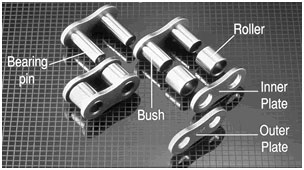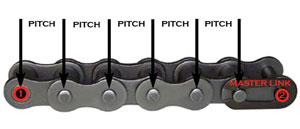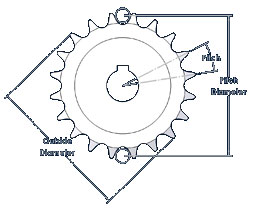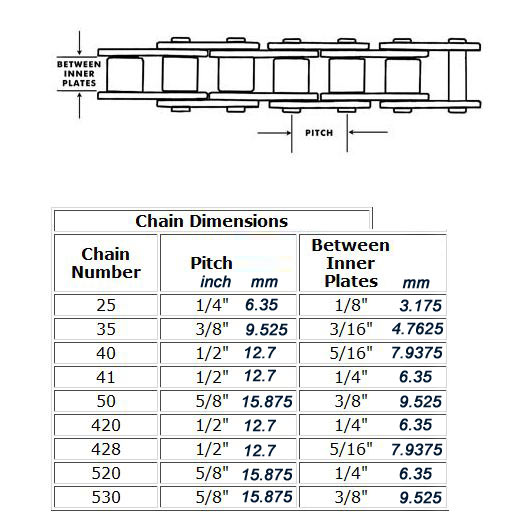GUIDE - Chain Pitch Identification
GUIDE - Chain Pitch Identification
Chains: The Missing Links
GUIDE How to identify and measure chains for Racing go-kart use
I am often asked the question “Will this chain fit my kart?” and “What is the best pitch to use for my project?” so I’ve decided to write this informative but straight-forward guide focussed on the two popular go-kart chain sizes 35 pitch and 219 pitch.
What is Pitch?
Firstly, to explain pitch we need to understand the basic components of the chain. A picture is a thousand words (so to speak) so here’s a diagram of an arbitrary chain:
 (picture from Renold.com)
(picture from Renold.com)
The pitch of the chain is basically the distance from centre of roller to centre of roller.
 (picture from hammerinhandcycles.com)
(picture from hammerinhandcycles.com)
Or, from the centre of the link plate to the centre of the next link plate (inner plate centre to outer plate centre).
This is the same distance between the tip of each tooth on a brand new sprocket of the same pitch:
 (picture from rustgears.com)
(picture from rustgears.com)
What types of chains are used on Racing Go Karts?
In Australia, we generally use one of two size chains to transmit power from engines to axles our karts. #35 pitch and #219 pitch. As a general rule of thumb, most 2-stroke karts use #219 pitch chain and most 4 stroke karts use #35 pitch chain, but this is not a hard and fast rule due to the benefits of each type of chain and the purpose of the go kart.
How do I know what pitch I have on my kart?
The easiest way to determine the pitch is to measure either a sprocket or a chain from your kart. If it’s #35 pitch it will measure approximately 10mm (9.525mm = 3/8 inch), if it’s #219 pitch it will measure approximately 8mm (7.774mm). The reason we measure approximately is because these tow chain pitches are measured in imperial inches rather than metric mm. 219 is a very unusual pitch as it is not 5/16 inch as often incorrectly reffered to as. It is wise to note that #219 pitch chain is not 8mm pitch chain – 8mm chain is Metric and is not used on Racing Go Karts in Australia in general.
#35 Pitch = approx 10mm (9.525mm)
#219 Pitch = approx 8mm (7.774mm)
#40 , #428, #41 & #420) = approx 13mm (12.70mm)
(*NOTE: 41 & 420P plates are spaced closer together (1/4") compared to 40 & 428P which are 5/16" - addtionally the rollers in the 428P chain are larger, so it may not mesh with 420P sprockets. Some clients have found 428P chain will work with some, usually smaller, 420 sprockets, however we have not tested this ourselves - it may allow you to solve an issue if you're in a bind)
If it’s not of the above pitches, you have a different chain pitch and we cannot offer you solutions at this time.
However, you can identify it by using the table below:

219P - distance between inner plates is approximately 4.77mm (roller width)
Where do the numbers 35 and 219 come from?
Pitch numbers are arbitrary numbers given to chain sizes as part of the ANSI (American Standard), ISO (International Standard) and BS (British Standard). 35 and 219 pitch chains do not derive their pitch number from any of their properties.
What are the benefits of 219 pitch chain?
1. Smaller diameter sprocket
a. Because 219 pitch chain has a smaller pitch (7.774mm), more links can occupy a given diameter of sprocket. That means a 219 sprocket with the same number of teeth as a 35 pitch sprocket will be smaller in diameter. That means a larger number of teeth can be used before sprockets foul on the ground or chassis. This improves gearing options.
2. Smoother power transmission / longer sprocket life
a. Because of the smaller pitch, teeth are closer so a more even drive force is transmitted per square mm of sprocket tooth. This reduces the amount of stress on each tooth and provides a marginally improved sprocket lifespan.
What are the disadvantages of 219 pitch chain?
1. Lower strength
a. Because the chain is made from less material, the strength of the components is lower.
2. Higher price
a. Because 219 pitch chain needs to be manufactured to a much higher quality to ensure durability, it is generally more expensive.
3. Fixed length / Non-Breakable
a. 219 pitch chain generally does not come with a removable link due to any removable links compromising the already close tolerance chain. While 219 pitch chain can be broken with a chain breaker, it is not recommended.
What are the benefits of 35 pitch chain?
1. Adjustable length / Breakable
a. Because 35 pitch chain is relatively strong, it can afford to compromise it’s strength and offer removable links. One of the biggest advantages of 35 pitch chain is the ability to lengthen or shorten it with a removable link. This also proves an enormous advantage where rear axles are driven ‘in-board’ with a sprocket between the bearings.
2. Higher Strength
a. Because 35 pitch chain has marginally larger components, it has increased strength.
3. Lower Price
a. Due to the ability to manufacture 35 pitch chain at good strength at a lower quality of manufacture, prices can be lower.
What are the disadvantages of 35 pitch chain?
1. Larger Sprocket Diameter
a. Because 35 pitch chain has a larger pitch (9.525mm), less links occupy a given diameter of sprocket. That means a 35 sprocket with the same number of teeth as a 219 pitch sprocket will be larger in diameter. This means a lower number of teeth can be used compared to 219 pitch before the sprocket fouls the ground or chassis. This reduces the gearing options.
2. Less-smooth power transmission / reduced sprocket life
a. Because of the larger pitch, teeth are further apart so a less even drive force is transmitted per square mm of sprocket tooth. This increases the amount of stress on each tooth and provides a marginally reduced sprocket lifespan.
What is the best type of chain to use for my Project?
Factors to consider when choosing an ideal pitch of chain would include:
1. In-board or out-board drive sprocket configuration
2. Availability of engine sprockets
3. Final desired gearing
4. Set-up difficulities (length of chain measurements)
2-Stroke Karts -Generally, for racing go karts which are of 2-stroke engine type, 219 pitch chain is the popular choice and offers a greater range of gearing options. Gearing can be fine-tuned more than 35 pitch and as such more front sprocket options are readily available. Most 2-stroke engines are run an out-board drive sprocket and therefore do not pose any problems with replacement of chain.
4-Stroke Karts -Generally for racing go karts which are of 4-stroke engine type, 35 pitch chain is the popular choice and offers better chain replacement access. Because 35 pitch chain can be easily broken and re-attached it is ideal for the in-board sprocket situation which occurs with 4-stroke engines on racing go kart chassis. Good kart shops will offer a range of 'split' 35 pitch sprockets which make replacing them easy on an in-board setup.
Projects -For a project, we often recommend using a 4-stroke engine and running the more flexible 35 pitch chain. Generally clutches are cheaper and setup is much easier being able to adjust the length of the chain easily.
WHY SHOULDN'T I USE 219P FOR 4STROKE RACING?
There are several reasons why this is the case.
Firstly, the 219P chain is designed for a lower torque and higher rpm so it tends to be less strong when used in a 4-stroke application.
Secondly, 219P generally does not have joining links (because joining links are inherently weak due to the thinner posts in each link) so it's much more difficult to fit to an inboard 4-stroke transmission– the only people selling joiner link chains are us from my understanding, but we don’t recommend them – they are a last-resort convenience for classes which use 4-stroke engines and 219P chain. The reason that happens is because a commercial decision was made to sell them for use on the 4-strokes in national classes which were a spin-off from 2-stroke racing. People like it because they can use their old 219P sprockets if they convert from 2-stroke. However, all it does is create massive headaches because the rear 219P sprockets aren’t split so they are difficult to change on a 4-stroke kart driving in-board. We do sell split sprockets in 219P but they are a convenience option, rather than a good idea.
Thirdly, #35 chain is stronger (when an equal quality 219P chain is compared against an equal quality #35 chain). We recommend using the RLV grade competition chains as they are much stronger than the base level CPR #35 chain. However, posts on #35 won’t break like 219P so all chains will work well. With the RLV, it’s often a good idea to use the tie-wire replacement joiner links (CHARJ1) as they can’t slip the circlip and leave you stranded mid-race. All #35 rear axle sprockets are split. So with quality split sprockets and chain you’ll have no problem adjusting ratios at the track with the same convenience as 2-strokes.
1. Measure the distance around your drive sprocket and rear sprocket with a tape measure (read off in mm) with your engine in it's standard position.
2. Divide the distance you measured in mm by the pitch of the chain you are using (219P = 7.774, #35P = 9.525)
eg: Tape measure reads approx 78cm (or 780mm) - if you're using 219P chain, divide by 7.774 (780 / 7.774 = 100.3)
3. Round up or down to the nearest whole value (100.3 rounded down is 100)
4. You need to order that number of links (in this example, 100L chain would be perfect).

















